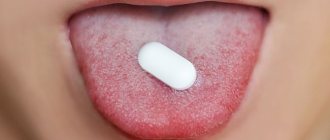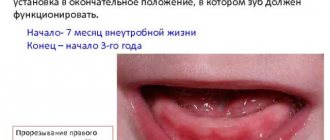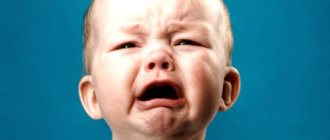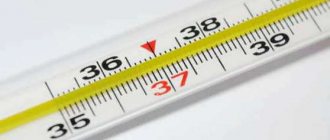Teething is a process characterized by the axial movement of teeth from a non-functional position (from the bone jaw tissue) to a functional position (on the surface of the alveolar process and gums). Most often, the formation of a temporary bite causes a lot of inconvenience, not only to the baby, but also to his worried parents. In this article from the “Pediatric Dentistry” section, we will try to figure out in what order baby teeth erupt, and what symptoms accompany the development of this process.
Teething: sequence and timing
Normally, teething in babies occurs according to the scheme below:
- central incisors: at 6 months. – in the lower dentition, at 8 months. – on the upper jaw;
- lateral incisors: at 10 months. – in the top row, at 11-13 months. – on the lower jaw;
- first molars (at one year of age);
- canines in the upper row (1 year 4 months);
- canines in the bottom row (1 year 6 months);
- second molars on both jaws (2 years).
The timing of the appearance of the first teeth can vary under the influence of many factors, including:
- toxicosis during pregnancy;
- the presence of Rh conflict;
- prematurity;
- receiving intracranial injury during childbirth;
- infectious diseases;
- congenital hypothyroidism;
- rickets;
- pathology of the pituitary gland;
- neonatal sepsis;
- refusal to breastfeed the baby;
- noticeable weakening of the immune system.
It has been proven that in first-born children, teething occurs much earlier than in infants born at a later time. Boys' first teeth appear later than in girls, while in children of old-time mothers - significantly earlier than in babies born to young parents.
When does a child start teething - table
From 4 to 7 months is the age when most children develop their first teeth. The sequence of their eruption is visible from the table.
| Name of teeth | Period of eruption, months. | |
| 1. | Incisors (central and lateral) | 4-12 |
| 2. | First molars | 12-19 |
| 3. | Fangs | 18-24 |
| 4. | Second molars | 24-32 |
The appearance of all 20 baby teeth occurs by the age of 3. But this process is individual, so small deviations in one direction or another should not cause anxiety in parents. If you are still concerned about early or late teething, then check this point with your pediatrician.
Factors influencing the timing of eruption:
- the nutritional pattern of the expectant mother;
- water quality;
- baby food ration;
- climatic living conditions;
- heredity.
There is usually nothing wrong with teething. But still, most children at this time experience discomfort and become restless.
Teething symptoms
There is an opinion that the appearance of the first teeth is accompanied by the development of a whole complex of pathological processes (fever, the appearance of a rash, abnormal stool, vomiting, convulsions, etc.). In fact, the formation of a temporary bite is a natural process that is not characterized by the symptoms described above. Pathologies detected during the teething period are most often manifestations of infectious diseases or a consequence of changes in diet.
In particular, factors that can lead to the appearance of unpleasant symptoms include:
- introduction of artificial complementary foods;
- hypovitaminosis;
- acute viral infections;
- stomatitis;
- tonsillitis;
- runny nose;
- otitis;
- vaccination, etc.
The true symptoms of teething are:
- hyperemia and gradual swelling of the gums;
- the appearance of a small bluish hematoma on the gum tissue;
- slight bleeding from the gums;
- wet cough;
- mild itching caused by mechanical irritation of sensitive nerve fibers in the gum tissue;
- increased salivation;
- various somnological disorders;
- sharp deterioration in appetite;
- tearfulness, capriciousness.
The danger of redness of the throat during this period
During teething, the baby's body weakens and becomes vulnerable to pathogenic bacteria or colds.
When a baby is teething, the child endlessly puts various objects into his mouth, which are not always sterilely clean. It introduces an infection and hyperemia of the tonsils occurs (tonsillitis, pharyngitis, sore throat occur), this is a very dangerous disease for such young children.
If some symptoms intensify and last more than 2-3 days (fever, red sore throat, runny nose with yellow or green discharge, cough or wheezing in the chest), you should consult a pediatrician.
Redness in the throat of a baby may be a sign of diseases:
- mechanical, thermal damage;
- tonsillitis;
- pharyngitis;
- laryngitis;
- tonsillitis;
- allergic reaction;
- ARVI;
- acute respiratory infections;
- diseases of the stomach, esophagus;
- problems with the nasopharynx.
First aid for teething
When baby teeth appear, the baby may require not only parental care, but also medical attention. The dentist may recommend that parents use anesthetic dental gels and treat the affected areas of the gums with decoctions of sage, oak bark or soda solution. If the pain is severe, the baby may be prescribed paracetamol, ibuprofen and other systemic painkillers.
To ease the discomfort that a child experiences when teething, it is necessary to use teethers - specialized devices made of rubber or plastic that the baby can bite and gnaw on without risking damage to the soft gum tissue. In addition, it is advisable to regularly massage the child’s gums with a finger wrapped in a clean, damp bandage.
Symptoms of physiological and pathological eruption of wisdom teeth
Tooth eruption can occur physiologically or pathologically. Discomfort occurs in any case, but if the “eight” grows without complications and other teeth do not interfere with it, inflammation usually does not occur. The complex of symptoms may vary, but most note the appearance of such phenomena as:
- engorgement and hardening of the gums;
- distension in the area of eruption;
- aching pain of varying intensity.
Important! Symptoms can vary significantly from person to person. Even one patient can experience completely different sensations when wisdom teeth erupt on the lower and upper jaws.
Severe pain, tumors, and inflammatory processes accompany pathological eruption. In this case, saving the tooth is not always advisable. If your wisdom tooth is cutting out and your gums hurt, you need to see a dentist.
Signs of pathological eruption are:
- constant, intense, aching pain;
- swelling of the gums or cheeks;
- inflammation of the lymph nodes;
- pain when swallowing;
- temperature increase.
Are you experiencing one or more symptoms? Don't delay your visit to the doctor. Such phenomena may be a sign of pericoronitis, purulent inflammation, abscess and other pathologies. Without adequate treatment, the inflammatory process will spread to adjacent tissues, and phlegmon will form in the oral cavity. In advanced cases, the problem can only be dealt with surgically in a hospital setting. Purulent inflammation is opened through external incisions, the treatment process is accompanied by the use of antibiotics.
Even if the symptoms of wisdom tooth eruption do not cause concern, it is recommended to visit a dentist. This is necessary to exclude a pathological process.
The doctor will refer you for an x-ray or computer examination. It helps determine the position of the new tooth relative to the existing ones and assess whether there is enough space for it. The photographs clearly show any deviations in the figure eight position. Based on the examination, the doctor will decide whether the wisdom tooth needs to be removed.
Caring for emerging teeth
Teething is an absolute reason for making the first visit to the pediatric dentist. During the consultation, the doctor identifies all deviations in the structure of the child’s dental apparatus, assesses the condition of the frenulum of his lips and tongue, draws up a dental care plan and a plan for preventive visits to the dental clinic.
It is advisable to brush emerging teeth twice a day. Initially, you should use a baby silicone brush or a small piece of gauze without toothpaste for cleaning. A regular toothbrush can be used when the child is one year old, and toothpaste when he reaches two years of age. In addition, it is important to pay attention to the process of enamel mineralization. In particular, it is necessary to limit the consumption of sweets and include foods enriched with calcium, phosphorus and ascorbic acid in the baby’s diet.
Wisdom tooth is cutting and gums are swollen
Pain and slight swelling can be physiological and caused by the impact of sharp bumps on the soft gum tissue. They can also be a symptom of a pathological process that develops due to lack of space for the normal eruption of the eighth tooth. As a result, the G8's growth is going in the wrong direction. A hood is formed over the crown, under which microparticles of food that cannot be removed by traditional hygiene methods fall, and an inflammatory process develops.
What to do if your wisdom tooth is cutting out and your gums are swollen? If your gums or cheeks are swollen, you need to go to the clinic.
Intense pain and tumor growth on the gums can signal various pathological processes:
- pericoronitis;
- purulent inflammation, abscess, phlegmon;
- periodontitis;
- granuloma, cyst.
If you have a problem similar to that described in this article, be sure to contact our specialists. Don't diagnose yourself!
Why you should call us now:
- We will answer all your questions in 3 minutes
- Free consultation
- The average work experience of doctors is 12 years
- Convenient location of clinics
Single contact phone number: +7
Make an appointment
There are often situations when a wisdom tooth is cut and the cheek is swollen. This usually happens if the inflammatory process begins to spread to soft tissue. A swollen cheek is a sign of the progress of purulent inflammation, and it is dangerous to further delay contacting a periodontist. In most such cases, the “eight” will have to be removed.
What kind of rash occurs and why does it occur?
A rash on a child’s body can appear for many reasons, not just when teething; it may also be that the parents simply gave the baby new complementary foods or he became infected with something. You need to make sure that the child is completely healthy and there are no allergenic substances around him, for example, low-quality household chemicals or food. Any of these factors can cause a child to develop a rash on any part of the body. It may appear as redness, be hard or flaky to the touch, itch or sting when touched, and may appear as clusters of pimples or blisters. In any of these cases, the first step is to visit a pediatrician.
If the rash is still not associated with any factors other than teething, you must first determine the location of its main location before moving on to treatment.
Where does the teething rash appear and can it spread beyond the baby's face?
As a rule, such a rash, which can be attributed to teething, begins in the area of the child’s head (face) and neck and looks like in the photo. It spreads in stages, from the place of first localization to more distant places on the body. The next stage is usually the arms, and then the rest of the body and legs. The rash itself feels like a very dry area, sometimes flaking, with increased skin temperature at the site of the rash. In any case, no matter what the rash looks like, it should always be under the careful supervision of parents.
If you notice a rash on your child’s face and are sure that he is absolutely not sick with anything, you should visit a doctor and consult with him what needs to be changed in the child’s routine so that the rash disappears.
General recommendations
As a rule, the teething period takes from 2 days to a week. And at this time, parents should be especially patient and affectionate towards the child. The best way to distract your baby is to try to redirect his attention.
It is necessary to pay enough attention to the child in order to distract him from pain and discomfort during teething.
You need to pick him up more often, offer him interesting toys, take walks (if the child feels normal). Now, during the quarantine period, try to ventilate the room as often as possible and go out to the balcony with your child. When walking, it is better to avoid crowded places and try to limit visits to the houses of strangers.
Babies who are breastfed are more likely to ask for the breast at this time. There is no need to refuse a child, as this calms him down. It is also not recommended to change the feeding regimen and introduce new types of complementary foods.
Many children put their toys in their mouths when teething begins. Therefore, it is necessary to monitor their cleanliness. The desire to chew something relieves discomfort. You can give the baby a special rubber ring, after thoroughly treating it with a soda-soap solution and keeping it in the refrigerator for some time to cool. Many kids willingly nibble on crackers, biscuits or cookies.









